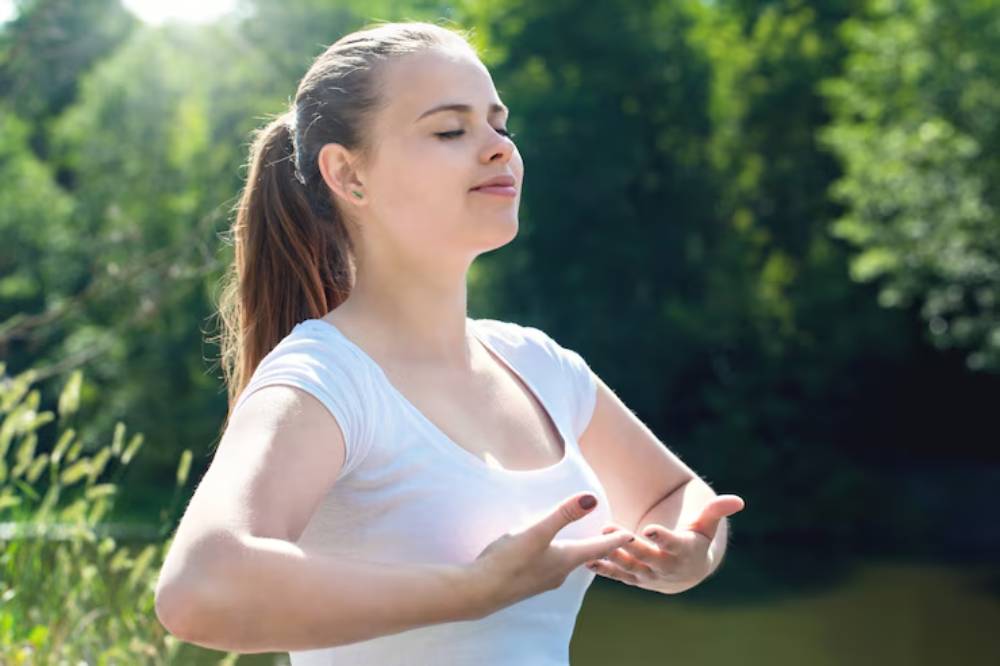The Health & Wellness Blog

How to Practice Mindful Breathing Throughout the Day
Today, in a fast-paced world, the age-old art of conscious breathing has set a new standard of calm and clarity. As life gets tougher, more people want to boost their mental health and stay balanced emotionally. Mindful breathing comes from mindfulness traditions and is an ancient practice. It grounds you in the present in a simple and profound way. This guide examines mindful breathing. It demonstrates how this practice can enhance mental health and increase life satisfaction.
Understanding the Core
Mindful breathing is not a relaxation tool. It is the most basic form of mindfulness practice. Mindful breathing means focusing on your breath. Notice each inhale and exhale without judging them. This activity helps people notice their thoughts, feelings, and bodily experiences. It promotes being present and accepting.
The Science Behind Mindful Breathing
Mindful breathing can help reduce stress. It lowers blood pressure and improves focus and concentration. Studies support these benefits. Researchers published a study in Psychosomatic Medicine. It shows that regular mindful breathing exercises can reduce anxiety and depression. This links to a response from the parasympathetic nervous system. This system helps the body relax and fights stress.
Pro Tip: If you’re new to mindful breathing, start with short sessions. Increase the length as you become more comfortable.
Quick Guide / Checklist
For those new to mindful breathing, here’s a quick checklist to get you started:
- Find a Quiet Space: Choose a location free from distractions.
- Set a Timer: Start with 5 minutes and gradually increase the duration.
- Focus on Your Breath: Pay attention to the natural rhythm of your breathing.
- Observe Thoughts: Acknowledge thoughts as they arise, then gently return focus to your breath.
- Practice Regularly: Aim for consistency, practising at the same time each day.
Important: Consider using guided meditation apps or recordings. They can help you stay focused and organised during your practice.
Step-by-Step Guide (How to Practise)
Step 1: Create a Conducive Environment
Find a comfortable and quiet space where you won’t be disturbed. This could be a dedicated meditation corner in your home or a peaceful spot in a nearby park. The aim is to minimise external distractions and focus fully on your breathing.
Step 2: Assume a Comfortable Position
Sit or lie down in a position that feels natural and relaxed. Ensure your spine is straight, and your shoulders are relaxed. If seated, place your hands on your knees or in your lap.
Step 3: Begin with Deep Breaths

Start by taking several deep breaths. Inhale slowly through your nose, allowing your chest and abdomen to expand fully. Hold your breath for a moment, then exhale gently through your mouth. This initial deep breathing helps to relax your body and centre your mind.
Step 4: Focus on Natural Breathing
Allow your breath to return to its natural rhythm. Focus your attention on the sensation of each breath entering and leaving your body. Notice how your chest rises and falls, and the feeling of air passing through your nostrils.
Step 5: Acknowledge and Release Thoughts
As you focus on your breathing, thoughts will inevitably arise. This is normal and part of the process. Acknowledge each thought without judgment. Then gently redirect your focus back to your breath.
Step 6: Gradually Increase Duration
Begin with 5 to 10 minutes of practice. Increase the time as you become more comfortable with the technique. Consistency is key. Try to practise mindful breathing daily.
Secret Tip: Mindful breathing is a skill that develops over time. Be patient with yourself and acknowledge your progress.
Best Practices & Additional Insights
Integrating Mindful Breathing into Daily Life
- Morning Routine: Begin your day with a few minutes of mindful breathing to set a positive tone.
- Work Breaks: Use mindful breathing during work breaks to refresh your mind and reduce stress.
- Evening Wind Down: Add mindful breathing into your evening routine. This will help in relaxation and improving sleep quality.
Enhancing Outcomes
- Combine with Physical Activity: Pair mindful breathing with yoga or tai chi to enhance physical and mental benefits.
- Practice Gratitude: End each session with a moment of gratitude, reflecting on positive aspects of your life.
- Community Practice: Join a mindfulness group or class to share experiences and gain new insights.
Warning: Avoid trying to control your breath. The goal is to observe, not to manipulate your breathing pattern.
FAQs
How often should I practise mindful breathing?
Aim to practise mindful breathing daily, even if only for a few minutes. Consistency is more important than duration.
Can mindful breathing help with anxiety?
Yes, mindful breathing can be an effective tool for managing anxiety. It helps to calm the mind and reduce the physiological symptoms of anxiety.
Do I need any special equipment?
No special equipment is required. All you need is a quiet space and a few minutes of uninterrupted time.
Is it normal to get distracted during mindful breathing?
Yes, distractions are completely normal. The key is to gently return your focus to your breath each time.
Can children practise mindful breathing?
Absolutely. Mindful breathing is simple and beneficial for people of all ages, including children.
What time of day is best for mindful breathing?
Anytime that suits you. Many find mornings or evenings most effective, but even short midday sessions are helpful.
How long before I notice benefits?
Some people feel calmer after just one session. Long-term benefits typically appear with consistent daily practice.
Can I do mindful breathing while walking or commuting?
Yes, mindful breathing can be practised anywhere. Just stay aware of your surroundings if you’re on the move.
Conclusion: Embrace Calm Through Conscious Breathing

Mindful breathing is more than a relaxation technique. It’s a gateway to greater self-awareness, emotional resilience, and everyday clarity. Meditation, even for a few minutes daily, helps your mind stay calm. It stops stress, distractions, and overthinking. It trains you to breathe and focus on the present. You might practise for five minutes in the morning or pause for a second in a busy afternoon. The benefits compound over time. It’s a gentle practice that fits into any lifestyle. It needs no special tools—your focus and a desire to pause.
Remember, it might take time to notice deep changes. They can be subtle at first, but they build up and have a strong impact over time. You may notice that you react more calmly under stress. You might sleep better or feel more connected to your environment. Mindful breathing serves as a constant home base—your oasis you can return to anytime. Explore more techniques, join mindfulness groups, or try other wellness practices to improve your experience. Your breath is always with you—use it to centre yourself, restore balance, and live more fully in each moment.









